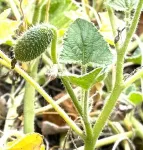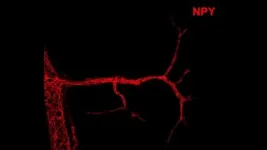(Press-News.org) UNDER EMBARGO UNTIL 20:00 GMT / 15:00 ET MONDAY 25 NOVEMBER 2024
New study reveals the explosive secret of the squirting cucumber
IMAGES AND VIDEO AVAILABLE – SEE NOTES SECTION BELOW
A team led by the University of Oxford has solved a mystery that has intrigued scientists for centuries: how does the squirting cucumber squirt? The findings, achieved through a combination of experiments, high-speed videography, image analysis, and advanced mathematical modelling, have been published today (25 November) in The Proceedings of the National Academy of Sciences (PNAS).
The squirting cucumber (Ecballium elaterium, from the Greek ‘ekballein,’ meaning to throw out) is named for the ballistic method the species uses to disperse its seeds. When ripe, the ovoid-shaped fruits detach from the stem and eject the seeds explosively in a high-pressure jet of mucilage. This projectile launch – lasting just 30 milliseconds- causes the seeds to reach speeds of around 20 metres per second, and land at distances up to 250 times the length of the fruit (around 10 m).
Until now, the exact mechanism of the squirting cucumber’s seed dispersal - and how this affects its reproductive success - remained poorly understood. In the new study, researchers from the University of Oxford and the University of Manchester conducted a variety of experiments on Ecballium specimens grown at the University of Oxford Botanic Garden.
This included filming the seed dispersal using a high-speed camera (capturing up to 8600 frames per second), measuring fruit and stem volume before and after dispersal, performing indentation tests and CT scans of an intact cucumber, and monitoring the fruit with time-lapse photography in the days leading up to launch. They then developed a suite of mathematical models to describe the mechanics of the pressurized fruit, the stem, and the ballistic trajectories of the seeds.
Using this combined approach, the team elucidated the key components of the plant’s dispersal strategy:
A pressurised system: In the weeks leading up to seed dispersal, the fruits become highly pressurised due to a build-up of mucilaginous fluid.
Fluid redistribution: In the days before dispersal, some of this fluid is redistributed from fruit to stem, making the stem longer, thicker, and stiffer. This causes the fruit to rotate from being nearly vertical to an angle close to 45°, a key element needed for successful seed launch.
A rapid recoil: In the first hundreds of microseconds of ejection, the tip of the stem recoils away from the fruit, causing the fruit to counter-rotate in the opposite direction.
Variable launch: Due to the components above, the seeds are ejected with an exit speed and launch angle that depend on their sequence: with subsequent seeds, the exit speed decreases (because the pressure of the now emptying fruit capsule decreases) while the launch angle increases (due to the fruit’s rotation). This causes the initial seeds to reach the furthest distance, with subsequent seeds landing closer. As multiple fruits are distributed around the centre of the plant, the overall result is a wide and nearly uniform distribution of seeds covering a ring-shaped area at a distance of between 2 and 10 m from the mother plant.
Together, these components make up a sophisticated seed dispersal system. In particular, the redistribution of fluid from the fruit back into the stem is thought to be unique within the plant kingdom.
Using the mathematical model, the researchers explored the consequences of artificially altering different parameters. This revealed that the seed projection method of the squirting cucumber has been fine-tuned to ensure near-optimal dispersal and the success of the plant over generations.
For instance, making the stem thicker and stiffer resulted in the seeds being launched almost horizontally, since the fruit would rotate less during discharge. This would cause the seeds to be distributed over a narrower area, with fewer likely to survive.
Meanwhile, reducing the amount of fluid redistributed from the fruit to the stem resulted in an over-pressurised fruit, causing the seed to be ejected at higher speeds but at a nearly vertical launch angle. Consequently, the seeds would not be dispersed far enough away from the parent plant, and again, few would survive.
Author Dr Chris Thorogood (Deputy Director and Head of Science at Oxford Botanic Garden) said: ‘For centuries people have asked how and why this extraordinary plant sends its seeds into the world in such a violent way. Now, as a team of biologists and mathematicians, we’ve finally begun to unravel this great botanical enigma.’
Co-author Dr Derek Moulton (Professor of Applied Mathematics at the Oxford Mathematical Institute) said: `The first time we inspected this plant in the Botanic Garden, the seed launch was so fast that we weren’t sure that it had actually happened. It was very exciting to dig in and uncover the mechanism of this unique plant.’
According to co-author Dr Finn Box, (Royal Society University Research Fellow, University of Manchester), ‘This research offers potential applications in bio-inspired engineering and material science, particularly on-demand drug delivery systems, for instance microcapsules that eject nanoparticles where precise control of rapid, directional release is crucial.’
Ecballium elaterium (pronounced: eck-ball-ee-uhm elaht-eh-ree-uhm) is a member of the gourd family (Cucurbitaceae) which also includes melon, pumpkin, squash, and courgette. The species is native to the Mediterranean, where – thanks to its effective seed-dispersal strategy- it is often regarded as a weed. The plant was described by the ancient Greeks and Romans: naturalist Pliny the Elder (AD 23/24 – AD 79) said ‘Unless, to prepare it, the cucumber be cut open before it is ripe, the seed spurts out, even endangering the eyes.’
Notes to editors:
For media requests and interviews, contact Caroline Wood: caroline.wood@admin.ox.ac.uk
Images and video relating to the study are available for use in articles here: https://drive.google.com/drive/folders/1R3AN88zAhu0xMXzYqGUkYkXLBz0noCHw?usp=drive_link These images are for editorial purposes relating to this press release only and MUST be credited (see captions file in folder). They MUST NOT be sold on to third parties.
The study ‘Uncovering the mechanical secrets of the squirting cucumber’ will be published in The Proceedings of the National Academy of Sciences (PNAS) from 20:00 GMT / 15:00 ET Monday 25 November 2024 at https://www.pnas.org/cgi/doi/10.1073/pnas.2410420121
To view a copy of the paper before this under embargo, access the PNAS area of EurekAlert here: https://www.eurekalert.org/news-releases/1065569 (this requires registration to EurekAlert).
About the University of Oxford Botanic Garden and Arboretum
Oxford Botanic Garden is the UK’s oldest botanic garden, founded in 1621. The Garden was first established as a physic garden for the cultivation of medicinal plants, and still occupies a unique position in terms of its history and academic location to this day. It was the birthplace of botanical science in the UK and has been a centre for plant research since the 1600s.
Oxford Botanic Garden’s mission is to share the scientific wonder of plants and the importance of plants with the world. It holds a collection of about 5,000 different types of plant, together with its sister site, Harcourt Arboretum. Some of these species exist nowhere else and are of international conservation importance.
About the University of Oxford
Oxford University has been placed number 1 in the Times Higher Education World University Rankings for the ninth year running, and number 3 in the QS World Rankings 2024. At the heart of this success are the twin-pillars of our ground-breaking research and innovation and our distinctive educational offer.
Oxford is world-famous for research and teaching excellence and home to some of the most talented people from across the globe. Our work helps the lives of millions, solving real-world problems through a huge network of partnerships and collaborations. The breadth and interdisciplinary nature of our research alongside our personalised approach to teaching sparks imaginative and inventive insights and solutions.
Through its research commercialisation arm, Oxford University Innovation, Oxford is the highest university patent filer in the UK and is ranked first in the UK for university spinouts, having created more than 300 new companies since 1988. Over a third of these companies have been created in the past five years. The university is a catalyst for prosperity in Oxfordshire and the United Kingdom, contributing £15.7 billion to the UK economy in 2018/19, and supports more than 28,000 full time jobs.
END
New study reveals the explosive secret of the squirting cucumber
2024-11-25
ELSE PRESS RELEASES FROM THIS DATE:
Vanderbilt authors find evidence that the hunger hormone leptin can direct neural development in a leptin receptor–independent manner
2024-11-25
Researchers from the Vanderbilt University School of Medicine Basic Sciences have uncovered the first example of activity-dependent development of hypothalamic neural circuitry. Although previous research has shown that the hormone leptin acts directly on hunger neurons through leptin receptors to promote the development of neural circuitry, results that will be published in PNAS on Nov. 25 indicate that certain neurons that do not express leptin receptors are nonetheless sensitive to its activity.
The research, led by the lab of Richard Simerly, Louise B. McGavock Professor and professor of molecular physiology ...
To design better water filters, MIT engineers look to manta rays
2024-11-25
Filter feeders are everywhere in the animal world, from tiny crustaceans and certain types of coral and krill, to various molluscs, barnacles, and even massive basking sharks and baleen whales. Now, MIT engineers have found that one filter feeder has evolved to sift food in ways that could improve the design of industrial water filters.
In a paper appearing this week in the Proceedings of the National Academy of Sciences, the team characterizes the filter-feeding mechanism of the mobula ray — a family of ...
Self-assembling proteins can be used for higher performance, more sustainable skincare products
2024-11-25
If you have a meticulous skincare routine, you know that personal skincare products (PSCPs) are a big business. The PSCP industry will reach $74.12 billion USD by 2027, with an annual growth rate of 8.64%. With such competition, companies are always looking to engineer themselves an edge, producing products that perform better without the downsides of current offerings.
In a new study published in ACS Applied Polymer Materials from the lab of Professor of Chemical and Biomolecular Engineering Jin Kim Montclare, researchers have created a novel protein-based gel as a potential ingredient in sustainable and high-performance PSCPs. This protein-based ...
Cannabis, maybe, for attention problems
2024-11-25
Cannabis — whether marijuana itself or various products containing cannabinoids and/or THC, the main psychoactive compound in weed – have been touted as panaceas for everything from anxiety and sleep problems to epilepsy and cancer pain.
Nursing researcher Jennie Ryan, PhD, at Thomas Jefferson University, studies the effects of cannabis on symptoms of attention deficit hyperactivity disorder (ADHD). Current medical guidelines for ADHD include medications such as Adderall and cognitive behavioral therapy. ...
Building a better path to recovery for OUD
2024-11-25
A new study led by Thomas Jefferson University researchers highlights critical healthcare gaps that hinder long-term recovery for people living with opioid use disorders (OUD) in Philadelphia.
The researchers conducted 13 focus groups with 70 participants accessing various types of OUD treatment. Participants reported several challenges, such as lengthy and restrictive assessment processes, inadequate operating hours and lack of sufficient withdrawal management. Participants also reported broader socio-economic needs, such as housing and income support, as barriers to their recovery.
Meghan Reed, PhD, MPH, senior ...
How climate change threatens this iconic Florida bird
2024-11-25
ITHACA, N.Y. – Because of warmer winters, Florida scrub-jays are now nesting one week earlier than they did in 1981. But these early birds are not always getting the worm.
A new analysis of data from a long-term study, published in Ornithological Advances, finds that warmer winters driven by climate change reduced the number of offspring raised annually by the federally threatened Florida scrub-jay by 25% since 1981.
Warmer temperatures, the scientists hypothesize, make jay nests susceptible to predation by snakes for a longer period of the Florida ...
Study reveals new factor involved in controlling calorie expenditure
2024-11-25
An international team of researchers has discovered a new component of the peripheral nervous system that acts by increasing energy metabolism in the body. The finding paves the way for the development of simpler and cheaper drugs to control obesity and weight gain, regardless of the amount of food ingested.
In an article published in the journal Nature, researchers from the University of Oxford in the United Kingdom and the Obesity and Comorbidities Research Center (OCRC) – funded by FAPESP and based at the State University of Campinas (UNICAMP) in Brazil – describe where and how this component ...
Managing forests with smart technologies
2024-11-25
Deforestation has remained a significant issue globally, with primary forests contributing to 16 per cent of the total tree cover loss in the last two decades, driven by climate change and intensive human activity. This threatens natural resources, biodiversity, and people’s quality of life. To protect forests, Lithuanian scientists, in collaboration with Swedish experts, have developed Forest 4.0, an intelligent forest data processing model integrating blockchain, Internet of Things (IoT), and Artificial Intelligence (AI) technologies. The system ...
Clinical trial finds that adding the chemotherapy pill temozolomide to radiation therapy improves survival in adult patients with a slow-growing type of brain tumor
2024-11-25
Both radiation and temozolomide, a generic chemotherapy treatment in pill form, have meaningful single-modality anti-tumor activity against slow-growing, low-grade gliomas. The randomized phase 3 trial E3F05 by the ECOG-ACRIN Cancer Research Group (ECOG-ACRIN) tested whether combined therapy using temozolomide alongside radiation therapy is more effective than radiation therapy alone in these patients. The trial followed 172 patients for more than 10 years, and its results have an immediate clinical impact by providing the first evidence from a randomized phase 3 trial that temozolomide improves long-term survival for these patients.
“We found that the 10-year ...
H.E.S.S. collaboration detects the most energetic cosmic-ray electrons and positrons ever observed
2024-11-25
The Universe teems with extreme environments, ranging from the very coldest temperatures to the highest energy sources possible. As a consequence, extreme objects such as supernova remnants, pulsars and active galactic nuclei are capable of emitting charged particles and gamma rays with incredibly high energies, so high that they exceed the energy produced by the nuclear fusion in stars by several orders of magnitude.
The gamma rays detected on Earth tell us a great deal about these sources, since they travel through space undisturbed. However, in the case of charged particles, ...








